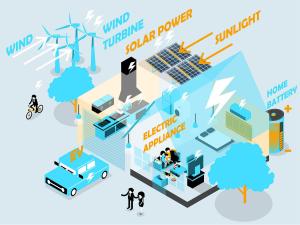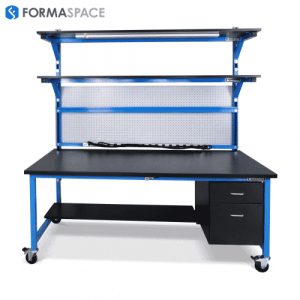
[ad_1]
Join us as we take a deep dive into the transformational changes to the industrial landscape that will unfold in the coming decade.
— Formaspace
AUSTIN, TEXAS, UNITED STATES, August 30, 2022 /EINPresswire.com/ — Major investments by governments and private companies alike are betting on transforming the economy into a new electric age, largely powered by renewables such as solar and wind power.
We take a look at how this major industrial change could unfold in the coming years – but beware –it’s going to be a bumpy ride, so fasten your seatbelts.
Can New Investments In Innovative Battery Design And Manufacturing Change The Game?
To power the new electric economy, billions of dollars of investment are pouring into battery research and development – as well as the construction of new battery manufacturing plants. Here are just a few of the recent investment announcements:
– South Korea’s LG Energy Solution, a major EV battery supplier for Tesla, GM, and Hyundai, is set to go public January 27 at an estimated value between 9 and 11 billion dollars.
– Japan’s Toyota Motor Corp plans to spend $13.6 billion on EV batteries by 2030 and has announced it will invest $1.25 billion to build a new EV battery factory in rural Randolph County, North Carolina, which is expected to create 1,750 jobs.
– Ford has announced the construction of new EV factories and battery manufacturing lines in Stanton, Tennessee, and Glendale, Kentucky, in partnership with SK Innovation. Ford expects to invest $11.4 billion and create nearly 11,000 new jobs.
– Tesla is constructing two new “Gigafactory” battery manufacturing facilities in Austin and in Berlin, plus a “Megapack” factory in California’s San Joaquin County, joining its existing battery factory in Sparks, Nevada, and factory and partner investments in Shanghai.
Manufacturers are keen to advance battery technology to make them cheaper to manufacture (by reducing the need for costly minerals, such as cobalt, for example), safer to operate (to avoid the risk of vehicle fires that bedeviled GM’s Bolt compact EV), increase their energy density (e.g. the power output for a given weight) and service lifespan (e.g. number of expected duty cycles) while at the same time reducing the time required for battery recharging.
Companies such as Tesla Motors are expected to adopt next-generation lithium iron phosphate (LiFePO4FP) batteries. These are considered safer to operate compared to more fire-prone lithium-ion (Li-ion) batteries and cheaper to manufacture as well, given that iron and phosphate cost far less than the nickel manganese cobalt (NMC) formulations used in Li-ion battery cathodes. Also, unlike conventional lithium-ion batteries, LiFePO4FP batteries can be recharged far more often without significant loss of power capacity.
Toyota is pursuing a different technology: next-generation solid state batteries. These do not use traditional electrolytes, which theoretically eliminates the risk of fire arising from a traditional battery’s exothermic (heat producing) reaction during charging, which can lead to thermal runaway (and fires). Toyota also claims their solid state batteries will allow cars to drive twice as far as conventional lithium-ion batteries and will be capable of recharging in 10 to 15 minutes.
Will Commercial And Residential Real Estate Properties Buy Into The Electric Renaissance?
New investments in updated electric power technology are also on the rise in the commercial and residential construction market.
And in a welcome sign for American manufacturing, new investment in solar panel manufacturing is happening here at home, thanks to a combination of tariffs and trade restrictions on Chinese solar technology as well as tax breaks for homeowners installing solar panels (more on that later).
The Hanwha Q Cells factory in Dalton, Georgia – once known for its carpet industry – produces more than 10,000 solar panels a day.
Roofing material manufacturers, such as the giant GAF, which boasts more than 10,000 contractors in its network, are also getting into the game; GAF is introducing a new line of nailable roofing shingles that have solar panels built into the exposed part of the shingle. GAF is hoping to leverage its distribution network to make inroads into a market first pioneered by Elon Musk’s Tesla Solar Panels.
Other changes are in the offing.
The EPA has heavily curtailed the use of most wood stoves due to their impact on air pollution. Regulators in California also plan to reduce pollution by banning the sale of small off-road engines (SORE) using internal combustion engines (ICE) by 2024, which is expected to affect lawn care equipment the most. Meanwhile, New York City has voted to ban natural gas hookups in new buildings to cut down on carbon emissions.
We’ll have more to say about these energy-saving measures in an upcoming article on NetZero building practices for commercial and residential construction projects – including advances in electric heat pumps and air conditioning systems.
Meanwhile, The Battery-Powered Transportation System Is Coming In Hot
The rapid transition to electric vehicles, which once felt so far in the future, is now upon us.
How quickly will this transition to an EV vehicle fleet take place?
One leading indicator is California, which will eliminate the sale of all ICE-powered vehicles by 2035.
Vehicle manufacturers are convinced that the future is electric – even Toyota (which beat GM in US manufacturing in 2021) has abandoned its longstanding strategy of hydrogen powered vehicles in favor of a massive, sudden shift into EV production plans – announcing its Lexus brand will go all-electric and plans to build 3.5 million EVs by 2030.
Another big surprise has been the interest in EV truck sales, which have produced the bulk of profits for domestic manufacturers. Ford sold out its initial production run of E-150 pickup trucks and now plans to build 150,000 units annually. (Ford is also offering electric crate motors to convert existing vehicles to electric, and its initial run also sold out.)
Startup electric pickup truck manufacturer Rivian went public in November 2021, closing the day valued at $86 billion; it plans to build 150,000 vehicles a year at its Normal, Illinois plant and invest $5 billion on a second manufacturing plant in Georgia capable of producing 400,000 vehicles annually.
Sensing an opportunity for a major comeback, SONY announced a plan to build its own branded EV at the 2022 Consumer Electronics Show in Las Vegas – perhaps stealing a march on the long-rumored electric car from its consumer electronics rival Apple.
But the EV revolution may not be a 1 to 1 replacement for our existing ICE vehicle fleets.
Analysts forecast a growing market for mobility services, such as E-bikes and even small personal city cars, such as the recently introduced Citroen Ami, a tiny low-speed vehicle that can be driven in France without a full driver’s license.
Increased Demand For Renewable Electricity Is Outstripping The Ability Of The Grid To Deliver Reliable Power
If you are an enthusiast for new technology, our electric future sounds exciting. After all, what’s not to like? We can imagine a world of quiet, non-polluting vehicles and buildings powered by low-cost, renewable energy sources, such as solar and wind.
But there is a fly in the ointment: our current electric grid can’t handle it.
Julia Solodovnikova
Formaspace
+1 800-251-1505
email us here
Visit us on social media:
Facebook
Twitter
LinkedIn
[ad_2]
Source link
The content is by EIN Presswire. Headlines of Today Media is not responsible for the content provided or any links related to this content. Headlines of Today Media is not responsible for the correctness, topicality or the quality of the content.



